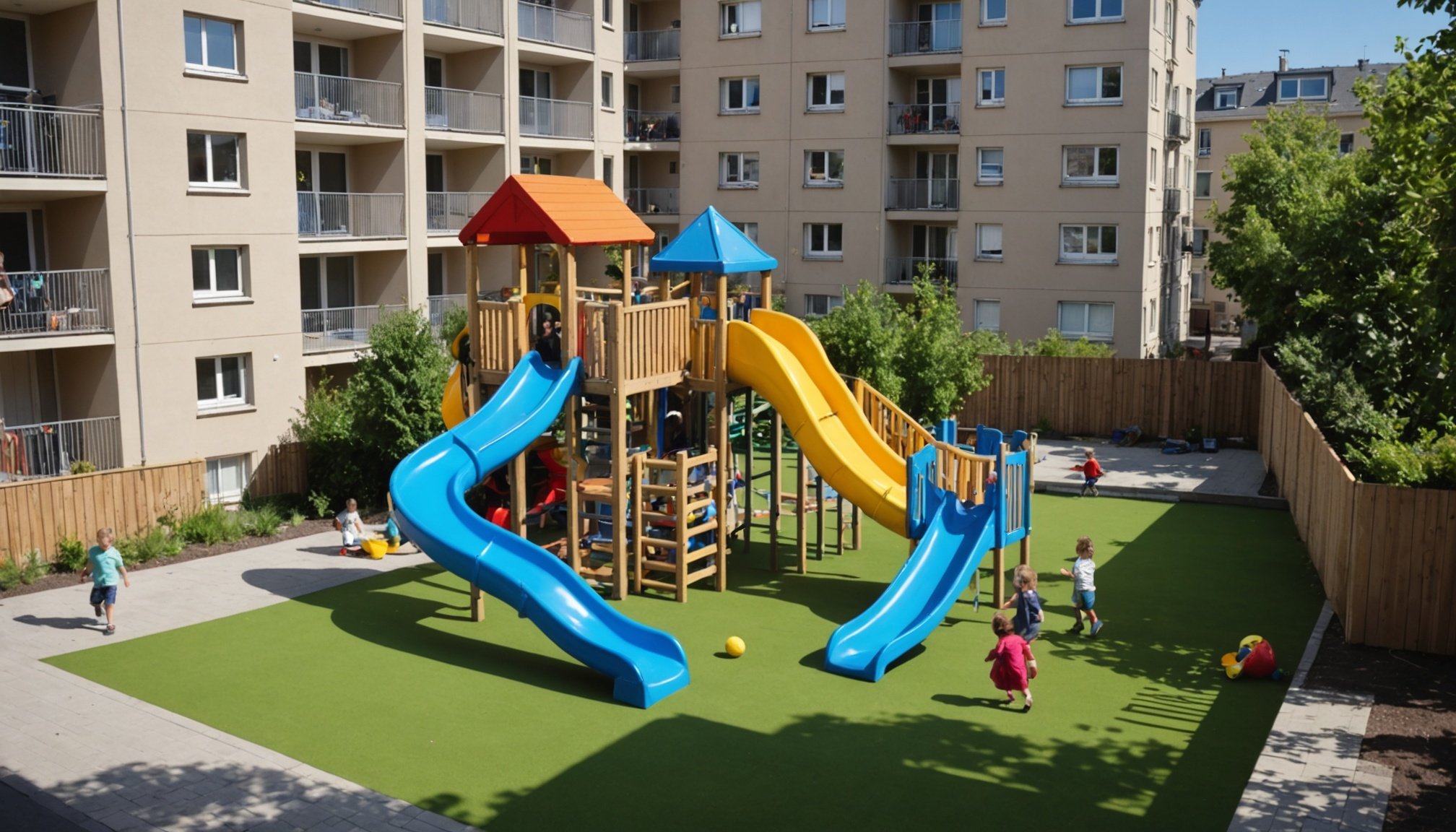Importance of Safe Play Spaces in Urban Apartment Communities
In urban apartment communities, ensuring that children have access to safe play spaces is paramount. Such environments offer significant child safety and physical health benefits. Play is critical for physical development; it enhances motor skills and increases physical activity, reducing the risk of childhood obesity. Furthermore, it provides an outlet for energy and creativity, contributing to mental well-being.
Community benefits extend beyond child health. Safe play spaces foster community engagement, encouraging interaction among residents and fostering a sense of belonging. These areas become hubs for conversation, cooperation, and mutual understanding, strengthening community cohesion. Neighbours who meet in these environments may form bonds that lead to a supportive and safer community atmosphere.
Have you seen this : Creating Family-Centric Urban Living Spaces: A Guide to Designing Child-Friendly Neighborhoods
Recognising the importance of playgrounds as essential components of urban infrastructure is vital. Incorporating them into the design of urban areas acknowledges their role not just in individual health but in the overall social fabric. These spaces are more than convenience; they are investments in healthier, engaged, and harmonious urban living. Expanding access to such resources should be a priority for urban planning initiatives focused on long-term community resilience.
Designing for Safety and Accessibility
Achieving safe design principles in children’s environments requires a blend of urban planning and careful consideration of accessibility standards. Ensuring these spaces are safe and accessible depends on adherence to various regulations.
Also read : Creating Inclusive Public Spaces: A Guide to Accessible Design in Mixed-Use Developments
Understanding Safety Standards
An understanding of both local and national safety regulations is fundamental in creating secure spaces for children. Critical safety elements include the selection of durable materials and ensuring that equipment is risk-free. Facilities must undergo regular inspections and ongoing maintenance to remain compliant with these standards. This vigilance helps prevent accidents and ensures the spaces are consistently safe.
Incorporating Accessibility for All Children
Designers should consider the needs of children with disabilities to create genuinely inclusive play areas. This includes thoughtful planning of the playground’s size and layout, ensuring that it accommodates those with mobility challenges. Furthermore, involving parents and caregivers in the design process is invaluable. Their insights can be instrumental in crafting environments that meet diverse needs and provide positive experiences for all children.
Ensuring a balance between safety and accessibility not only protects children but also fosters an atmosphere where every child can thrive and play comfortably.
Creating Engaging Play Spaces
Designing engaging play environments is essential for nurturing a child’s imagination and creativity. Imaginative play significantly contributes to child development by fostering cognitive and social skills. It enables children to concoct scenarios, solve problems, and understand the world around them in a safe setting.
Creating varied play zones, like active areas for movement, quiet corners for relaxation, and sensory spaces rich in texture and colour, caters to diverse developmental needs. For active zones, incorporate elements like climbing structures or open spaces for running, which aid in physical development and coordination. Quiet zones might include cozy nooks with soft seating and books, fostering tranquillity and concentration.
Incorporating natural elements into these spaces can significantly increase a child’s interaction and curiosity. The use of landscaping, such as adding sand pits, water features, or garden sections, can transform a mundane area into an engaging adventure ground. These elements not only provide enjoyment but also encourage children to explore and learn about nature.
Fostering creativity through thoughtfully designed play spaces ensures that children gain comprehensive developmental benefits, preparing them for future educational experiences and social interactions.
Community Engagement in Play Space Design
Fostering community involvement in play space design ensures that spaces cater to the needs and desires of local residents. Engaging the community through collaborative design is essential for creating spaces that are both functional and inclusive.
Strategies for Involving Local Residents
Resident feedback is crucial in planning play spaces. Local residents provide invaluable insights into what might work best for their community. One effective strategy is conducting surveys which allow for resident input on key decisions. Surveys can cover topics ranging from desired amenities to safety concerns. In addition, hosting community meetings provides a platform for discussions where residents can voice their opinions and collaborate directly with planners.
Creating partnerships with local organizations can enhance community engagement. These organizations often have established relationships with residents and can facilitate communication, ensuring all voices are heard and considered.
Case Studies of Successful Community Engagement
Urban areas have seen positive outcomes from embedding community involvement in design processes. For instance, some apartment communities engaged residents from early stages, resulting in play areas that were well-received and frequently used. The success stories highlight the importance of initial and ongoing collaboration, where lessons learned indicate that continuous resident involvement leads to sustainable satisfaction and better-maintained spaces.
Selecting Materials and Equipment
Choosing the right play materials and equipment is vital for safety and engagement. Safety should be a primary consideration. Select items made from safe materials that meet stringent safety guidelines, like non-toxic, fire-resistant, and non-choking hazards. Durability ensures that the equipment withstands extensive use, making it a cost-effective investment. Look for sturdy, well-constructed items, as these reduce the need for frequent replacements.
When considering age-appropriate play, it’s crucial to match toys and equipment with the developmental stage and abilities of the children. Toys that are too advanced may pose safety risks or discourage interest, while those too simple might not stimulate engagement or learning. Manufacturers usually provide age recommendations on packaging, which is a helpful guide in making suitable selections.
Environmental considerations also play a significant role. Opt for environmentally friendly materials, like sustainably-sourced wood or recycled plastics, to minimise your environmental footprint. Such choices uphold ecological responsibility while ensuring the materials in contact with children are healthy and safe.
In sum, prioritising safety, durability, age-appropriateness, and environmental impact manages risks and enhances the overall play experience.
Ongoing Maintenance and Improvement
Regular maintenance strategies and enhancements ensure play spaces remain safe, welcoming, and engaging for all. Continuous attention to upkeep improves longevity and effectiveness, crucial for community satisfaction.
Establishing Maintenance Protocols
Creating clear maintenance protocols is fundamental. A recommended maintenance schedule should include periodic inspections and routine checklists. These protocols highlight tasks like equipment checks, surface cleaning, and hazard removals.
Community involvement plays a critical role in this process. Engaging locals in regular upkeep can enhance responsibility and pride, fostering a sense of ownership over shared spaces. Furthermore, it is essential to develop sustainable strategies for funding ongoing maintenance. Options might include community fundraisers, local business sponsorships, and municipal support.
Assessing and Improving Play Spaces Over Time
To assess play space effectiveness, various tools can be applied. Feedback forms, observation, and user engagement metrics are invaluable for understanding how spaces meet community needs. Assessments help in identifying areas for redesign.
Adaptability remains key. As community demographics and preferences evolve, play spaces must be flexible enough to accommodate these changes. Incorporating community feedback into redesigns ensures spaces remain relevant and stimulating. This approach guarantees that play spaces continue to serve their intended purpose effectively.











